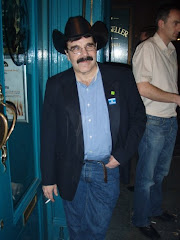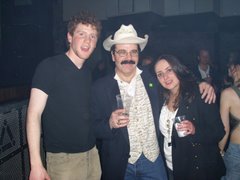Republican Politics, American Style
Published on October 25th 2007 in Metro Eireann By Charles Laffiteau
. Last week I called the race for the Republican presidential nomination a toss-up in spite of Rudy Giuliani’s double digit lead over his three main rivals. On the Democratic side Hillary Clinton now holds an even wider margin of support from the nation’s Democratic voters over her three closest rivals for the Presidential nomination. Indeed the Republican Presidential candidates and many political analysts have already decided that Hillary will win the Democratic nomination and have begun to attack her and her positions on national election issues accordingly. But I think a closer look at the numbers reveals that some of Clinton’s support is actually softer than it would appear to be at first glance.
Hillary has been doing quite well of late and it shows not just in the opinion polls but also at the bank. Money talks and for the first time Hillary Clinton raised more money than her closest rival Barack Obama ($27 million versus $20 million in the third quarter) while John Edwards and Bill Richardson were raising another $7 million and $5 million respectively. The remaining Democratic Presidential candidates like Senator’s Christopher Dodd and Joe Biden are failing to gain much traction with their campaign donations trickling in around the $1 million dollar mark..
Prior to these latest fundraising figures, Barack Obama had bested Clinton in terms of raising money, particularly campaign donations that could be used in the Democratic primary battles as opposed to funds that could only be used in the 2008 General Election if that candidate won the Democratic nomination for President. Since the beginning of the year, both candidates have now raised approximately $75 million that can be used in the Democratic Party primary election campaigns
Where Hillary has a real edge is the $15 million she already has in the bank for the General election as opposed to only $4 million for Senator Obama. While both Clinton and Obama have been spending heavily on TV advertising in the early primary states of Iowa, New Hampshire and South Carolina, Hillary still has a bit more cash on hand ($35 million to $32 million for Obama) to use in the remaining three months before primary voters go to the polls in these states. By comparison, Senator Edwards has a third less money (around $10 million) and Bill Richardson less than a fifth of the front-runners cash reserves with only $5 million left to use in the next three months. But now let’s take a closer look at Hillary’s numbers.
For starters, Mrs. Clinton has raised most of her money by tapping the wallets of wealthy Democratic supporters for the maximum amounts ($2,300 per person) that they can contribute in both the Democratic primary and General elections. There are only so many of these kinds of contributors and going back to them for more donations at a later date isn’t an option for Hillary. Another source of much of Clinton’s campaign cash has been Political Action Committees (PACS)which are used by Washington lobbyists to funnel money to candidates they believe will be friendly to the business interests they represent should they be elected. Finally, Hillary has also transferred millions of dollars left over from her successful US Senate campaign to her Presidential campaign fund.
On the other hand, Senator Obama did not have any such millions left over from his US Senate campaign to use as seed money for a Presidential bid, nor has Barack Obama’s campaign accepted any PAC’s or lobbyists’ money. Thus the $75 million Obama has for his Democratic Presidential primary battles was raised without transferring one cent from any other campaign fund and with no money from federal lobbyists or PACs. Furthermore, very few of Obama’s supporters have yet given the $2,300 maximum allowed by US law.
This is a reflection of the huge number of grassroots supporters Barack Obama has drawn to his campaign for the Presidency. Senator Obama has received considerable attention for his use of the internet to help build a base of over 450,000 financial contributors during the first nine months of his campaign. This number is more than double the quantity of campaign donors Hillary Clinton has and, more importantly, these are people who are still in a position to give more money to his campaign at a later date if asked to do so.
So the next three months will be crucial ones for Barack Obama and the other Democratic challengers, including the surprisingly effective dark horse candidate, Bill Richardson of New Mexico. Obama, Edwards and Richardson must demonstrate that they can continue to raise money in the face of disappointing poll numbers versus Clinton, if they hope to sustain their respective Presidential campaigns through the first round of twenty plus state primaries in January and February of next year.
If Hillary loses in a half a dozen or more of these states then I expect to see her current big lead in voter opinion polls evaporate by the time March rolls around because voter support for her is soft if one looks below the surface. I think that much of Mrs. Clinton’s support in the polls derives not from her positions on issues like universal health care or ending the US role in Iraq, but from voter identification with and recognition of her spouse, former President Bill Clinton.
Last spring, in response to worries about the grassroots campaign strength of Barack Obama, Hillary’s campaign advisors decided to feature the former president much more prominently in her Presidential campaign. Bill Clinton’s role had previously been more of a behind the scenes one at fund raisers for wealthy contributors than out on the campaign trail at voter rallies. The former President was and still is a very effective political campaigner and ever since that decision last spring he has been front and centre during his wife’s Presidential campaign.
As President Bush’s approval ratings have dropped to and remained at historically low levels during the course of this past year, the approval ratings of the former President have soared as voters yearn for the “good old days”. But a vote for Hillary is not the same thing as a vote for a return to the “good old days” of the Bill Clinton Presidency. I suspect that once Hillary’s rivals start to hone in on this particular point, some of her current supporters will begin to more carefully consider another Clinton Presidency and then the race for the Democratic nomination will tighten considerably. I could be wrong, but I still see this race as a toss-up too.
Sunday, December 16, 2007
Subscribe to:
Post Comments (Atom)



No comments:
Post a Comment